Theme 3
Atmospheric climate forcers in the Arctic

PI : Makoto Koike (NIPR)
Background of the Research
The Arctic is warming. The main driver is an increase in the global atmospheric concentration of carbon dioxide (CO2), which is a long-lived greenhouse gas (GHG). In addition, short-lived climate forcers (SLCFs), such as black carbon aerosol (BC) and gaseous methane (CH4), potentially make a large contribution to Arctic climate change. BC efficiently absorbs solar radiation, potentially leading to an acceleration of ice-albedo feedback. CH4 emissions from thawing permafrost will potentially enhance Arctic warming, thus leading to positive feedback. However, there are large uncertainties in their behaviors and impacts. The Arctic Council’s AMAP (Arctic Monitoring and Assessment Programme) has reported that there is a need for further systematic studies of GHGs and SLCFs.
Overview of the Research
The aim of this study is to characterize behaviors of SLCFs (such as BC and CH4) and other GHGs in the Arctic atmosphere and to quantify contributions of individual sources/sinks or fluxes of these compounds. We measure atmospheric BC (at selected sites, by aircraft and ship) in the Arctic using high-accuracy instruments, which we have developed. A technique to measure BC in precipitation (rain and snow) and snow on the ground has also been developed, and we evaluate wet deposition flux of BC in the Arctic. Using advanced numerical models, we evaluate contributions of individual BC sources (regions and source types). We also characterize behaviors of clouds using in-situ, radar/lidar, and satellite measurements.
To study GHG flux, we combine top-down and bottom-up approaches. In the former method, we estimate fluxes from atmospheric concentration measurements using numerical models. In the latter method, we directly measure fluxes at a number of representative sites and estimate fluxes from a wide area over the Arctic. By conducting these high-accuracy measurements and using advanced numerical models, we characterize temporal and spatial variations in sources/sinks of GHGs. We also estimate responses of sources and sinks with respect to climate/environmental changes.
We would like to enhance international collaborations, in which we have been working with many institutions and universities around the world, and make significant contributions to Arctic communities. We would also like to provide a scientific basis for examining strategies to mitigate Arctic climate change.
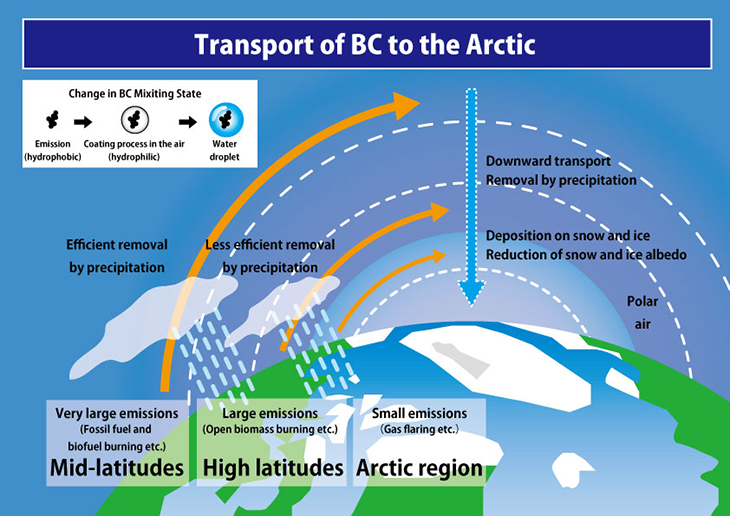
Transport of BC from source regions to the Arctic and aging and removal processes during transport
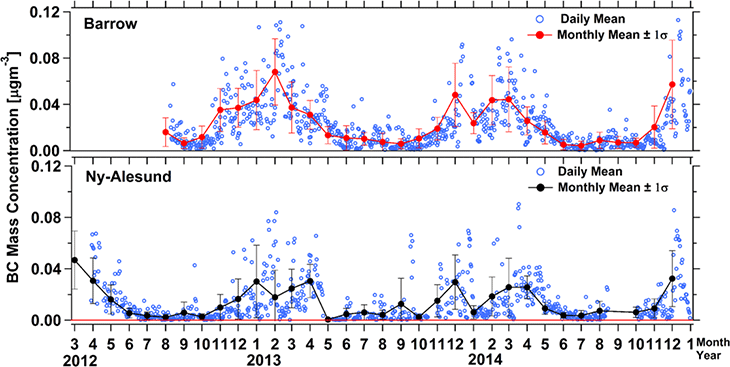
BC mass concentrations observed in Barrow (Alaska) and Ny-Ålesund (Norway)
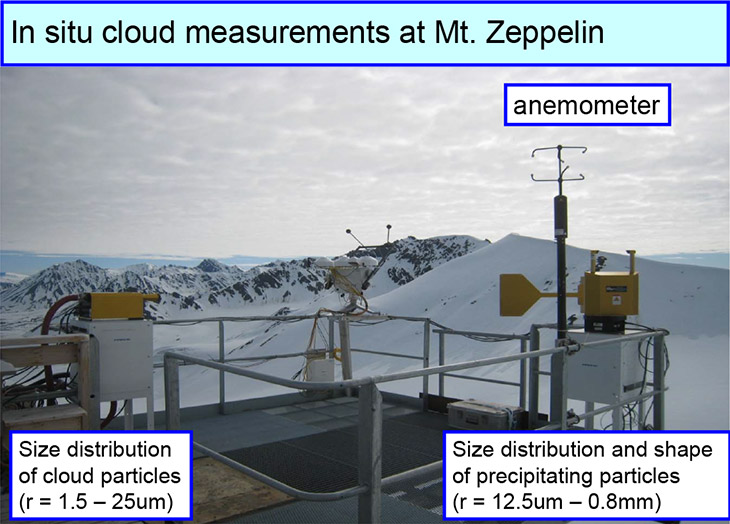
In situ cloud measurements at Mt Zeppelin, Ny-Ålesund
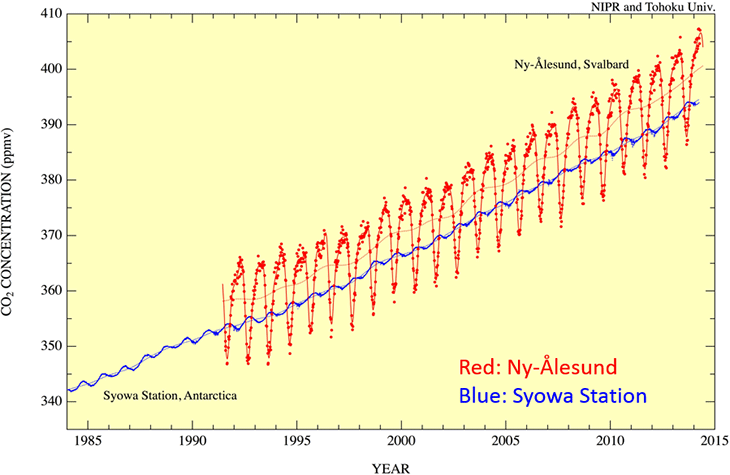
Temporal variations in atmospheric CO2 concentrations observed at Ny-Ålesund, Svalbard and Syowa Station, Antarctica.
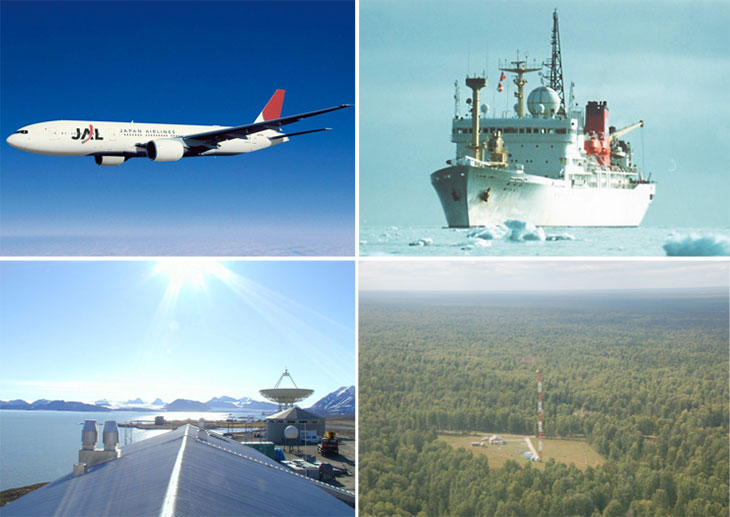
Platforms for the atmospheric observations: commercial airliner, research vessel, ground observatory and tower.
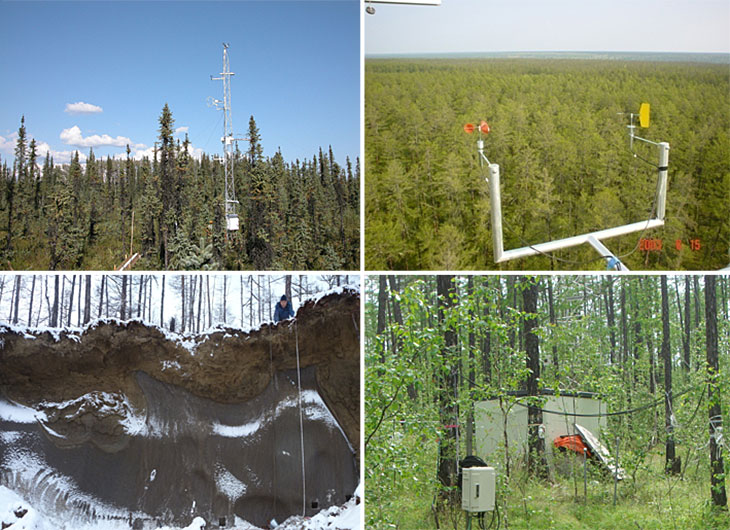
Observations of terrestrial greenhouse gas fluxes and soil organic carbon.
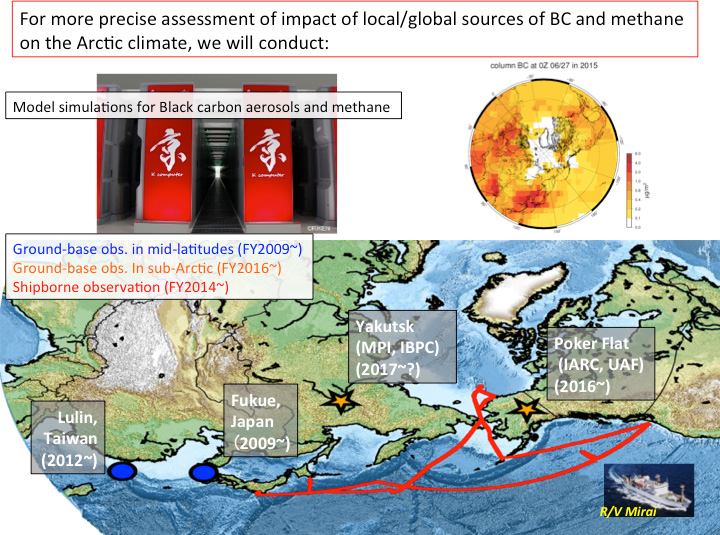
Conceptual figure of SLCF assesment
Cooperative Institutions / International Projects
Alfred Wegener Institute (Germany), Norwegian Polar Institute (Norway), National Oceanic and Atmospheric Administration (US), Arctic and Antarctic Research Institute (Russia), Stockholm University (Sweaden), Norwegian Institute for Air Research (Norway), The Institute of Atmospheric Sciences and Climate (Italy), University of Florence (Italy), MSC-EC (Canada), University of East Anglia (UK), University of Alaska (US), IARC (US), Russian Academy of Sciences (Russia), IBPC (Russia), MPI (Russia), Moscow State University (Russia), Central Aerological Observatory (Russia)
IGAC, IASC, PACES, CCAC/UNEP
Implementation Structure
Members
| Name | Institutes |
|---|---|
| Makoto Koike | National Institute of Polar Research/The University of Tokyo |
| Shinji Morimoto | Tohoku University |
| Tetsuya Hiyama | Nagoya University |
| Masayuki Takigawa | JAMSTEC |
| Yutaka Kondo | National Institute of Polar Research |
| Yutaka Tobo | National Institute of Polar Research |
| Daisuke Goto | National Institute of Polar Research |
| Nobuhiro Moteki | The University of Tokyo |
| Shuji Aoki | Tohoku University |
| Yoichi Inai | Tohoku University |
| Ayumi Kotani | Nagoya University |
| Hironari Kanamori | Nagoya University |
| Hitoshi Matsui | Nagoya University |
| Hajine Okamoto | Kyushu University |
| Kaori Sato | Kyushu University |
| Name | Institutes |
|---|---|
| Kazuyo Yamaji | Kobe University |
| Masahito Ueyama | Osaka Prefecture University |
| Yoshinobu Harazono | Osaka Prefecture University |
| Hiroshi Ohno | Kitami Institute of Technology |
| Konosuke Sugiura | University of Toyama |
| Kazuyuki Saito | JAMSTEC |
| Shin Nagai | JAMSTEC |
| Yugo Kanaya | JAMSTEC |
| Prabir K. Patra | JAMSTEC |
| Hideki Kobayashi | JAMSTEC |
| Fumikazu Taketani | JAMSTEC |
| Kazuyuki Miyazaki | JAMSTEC |
| Takuma Miyakawa | JAMSTEC |
| Hisashi Sato | JAMSTEC |
| Keiko Konya | JAMSTEC |
| Petr Mordovskoi | JAMSTEC |
| Masahiro Yamaguchi | JAMSTEC |
| Chunmao Zhu | JAMSTEC |
Collaborators
| Name | Institutes |
|---|---|
| Kumiko Goto-Azuma | National Institute of Polar Research |
| Hisashi Nakamura | The University of Tokyo |
| Masaki Sato | The University of Tokyo |
| Takaaki Takano | Chiba University |
| Nobuyuki Takegawa | Tokyo Metropolitan University |
| Jinro Ukita | Niigata University |
| Hiroki Iwata | Shinshu University |
| Tempei Hashino | Kochi University of Technology |
| Teruo Aoki | National Institute of Polar Research |
| Naruki Hiranuma | West Texas A&M University |
| Taro Nakai | National Taiwan University |
| Name | Institutes |
|---|---|
| Go Iwahana | University of Alaska Fairbanks |
| Naga Oshima | Meteorological Research Institute |
| Hidekazu Matsueda | Meteorological Research Institute |
| Toshinobu Machida | National Institute for Environmental Studies |
| Yasunori Tohjima | National Institute for Environmental Studies |
| Akihiko Ito | National Institute for Environmental Studies |
| S. Maksyutov | National Institute for Environmental Studies |
| Tomoaki Nishizawa | National Institute for Environmental Studies |
| Shohei Murayama | National Institute of Advanced Industrial Science and Technology (AIST) |
| Shigeyuki Ishidoya | National Institute of Advanced Industrial Science and Technology (AIST) |
| Ryo Fujita | Imperial College London |
| Yasunori Igarashi | Fukushima University |
Study Sites (Map)
- ❶Ny-Ålesund (Norway)
- ❷Barrow (Alaska, US)
- ❸Baranova (Russia)
- ❹Nord (Greenland)
- ❺Siberia
- ❻Bering Sea
- ❼Arctic Sea
- ❽Northern Pacific
- ❾Alaska
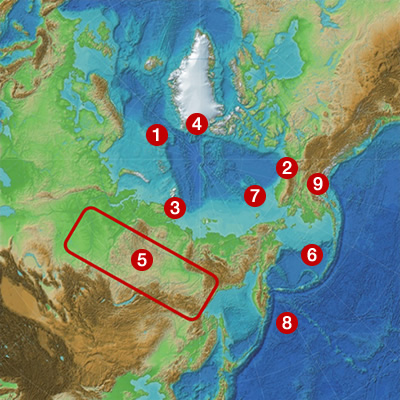
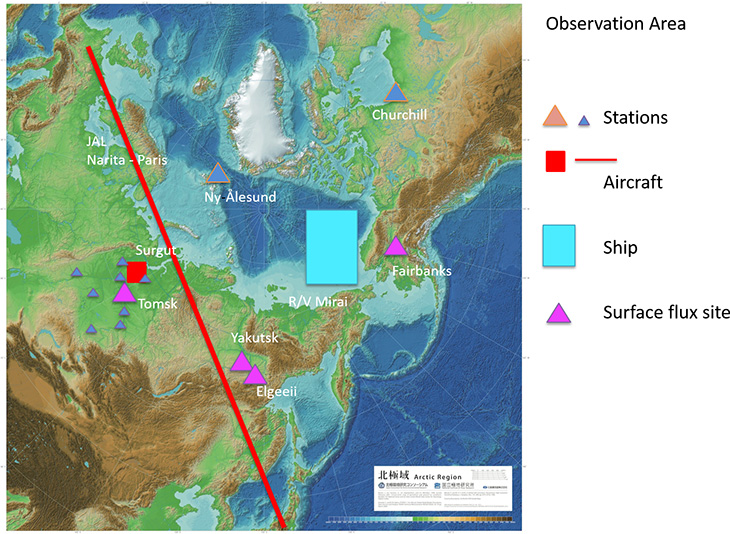
ArCS Blog
- Installation of a spectrometer for atmospheric greenhouse gases on a research vessel “MIRAI” (MIRAI Arctic cruise 2018) (November 08, 2018)
- Ship-based observations of atmospheric aerosols and gases over the Arctic Ocean (MIRAI Arctic cruise 2018) (November 08, 2018)
- Observation campaign Arctic-CARE 2017 is ending (April 12, 2017)
- Observation campaign Arctic-CARE 2017 started! (March 17, 2017)
- Greenhouse gas observation using commercial airliners (September 16, 2016)
- Installation of atmospheric greenhouse gases measurements system on research vessel MIRAI (MIRAI Arctic cruise 2016: Theme 3) (September 14, 2016)
- Additional questions about the news release to Dr. Taketani (March 24, 2016)




